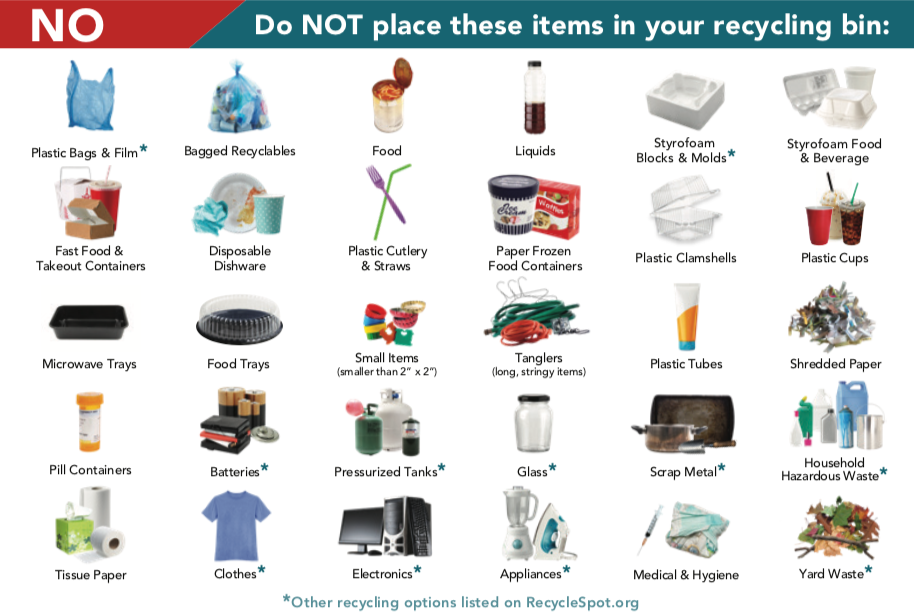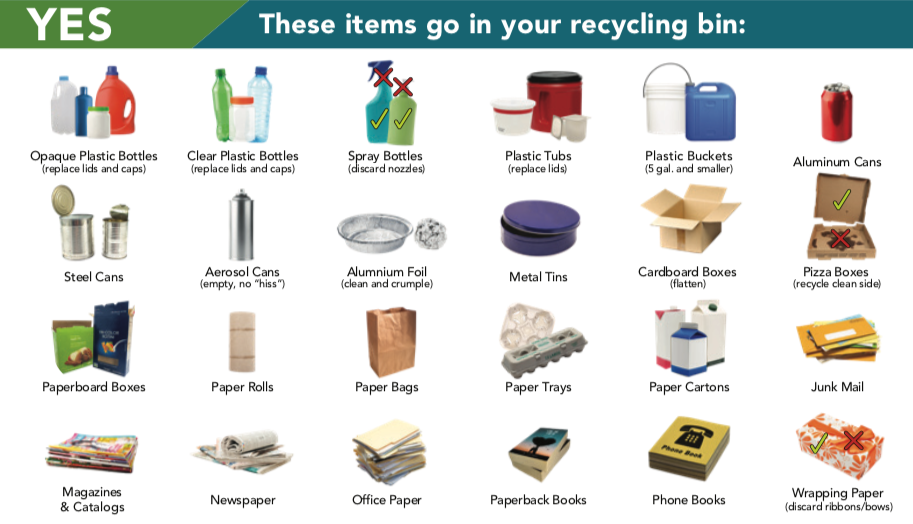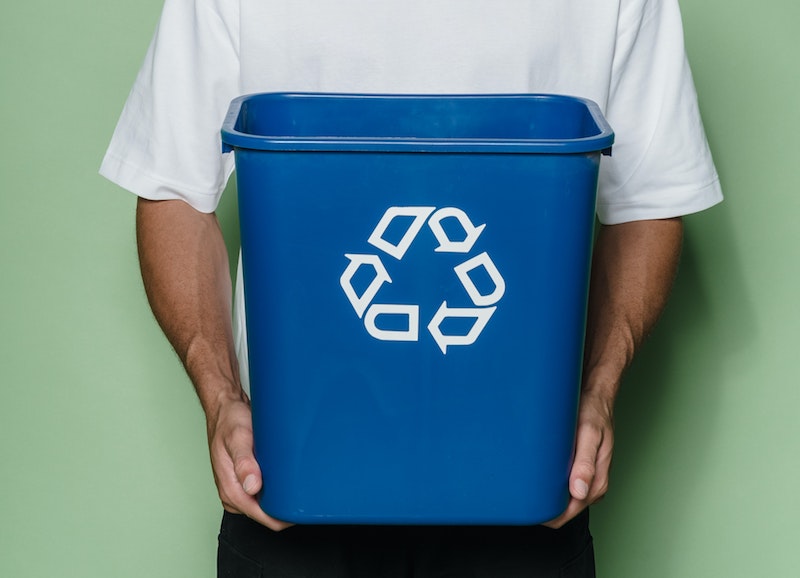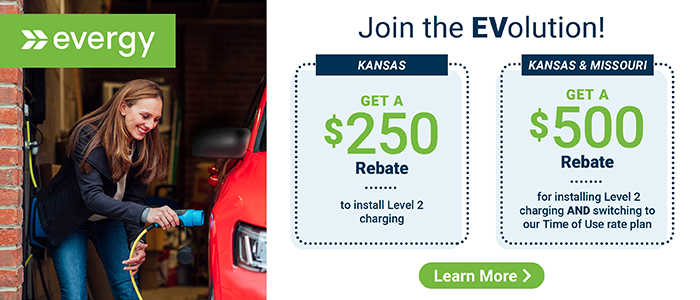Learn how to recycle at home, what items can go in your recycling bin, and what items should be trashed.
There are new guidelines for curbside recycling in the Kansas City metro. Recyclespot.org, a program of the Mid-America Regional Council (MARC) Solid Waste Management District, has updated the regional recycling guidelines alongside local recycling haulers and sorting facilities.
According to MARC, approximately 25% of what people put in their bins is not recycled and ends up in the landfill.
There are many changes to what plastics can be recycled. Under the old guidelines, plastics with the chasing arrow resin codes 1-7 were accepted. Now, fewer plastics are able to be recycled.
Here is an overview on what you can and can’t recycle, including tips on how to recycle plastic. Plus, don’t miss the new Recyclespot.org Recycle Better flyer to download and share.
If you’re anything like us, reading this might get overwhelming. At the end, we’ve got our top tips to get started and keep it simple. Let’s do this!
Items that can’t be recycled curbside

New guidance from Recyclespot.org’s Recycle Better flyer
Plastics that can’t be recycled include:
- Plastic bags and films* can’t be recycled curbside, but are accepted at grocery store drop-offs. Check your local store, or Lowe’s, Target, or Walmart.
- Plastic clamshells such as for fruit, berries, dessert, or takeout containers
- Plastic cups and straws from fast food, coffee shops, or convenience stores
- Plastic pill containers
- Plastic microwave trays and food trays
- Plastic cutlery & straws
- Plastic tubes such as for toothpaste
- Small items less than 2 inches by 2 inches (screw plastic lids on to recyclable items)
Other items that can’t be recycled curbside include receipts, bagged recyclables, foods and liquids, styrofoam blocks and molds*, styrofoam food containers, fast food and takeout containers, disposable dishware such as plates and cups, paper frozen food containers, tanglers that can get stuck in recycling sorters (such as hangers, hoses, etc.), shredded paper, batteries*, household hazardous waste*, pressurized tanks*, glass*, scrap metal*, tissue paper, clothes*, electronics and appliances*, medical and hygiene items, and yard waste*.
*Other recycling options are available for these items on recyclespot.org
Items that can be recycled curbside

New guidance from Recyclespot.org’s Recycle Better flyer
All food-related items that you recycle should be well-rinsed and empty. They don’t need to be perfectly clean, but should be clear of grease and most food particles. Water and soda bottles can’t have any liquids in them.
- Paper & cardboard that can be recycled includes:
- Cardboard boxes (flattened)
- Pizza box tops (the greasy side cannot be recycled)
- Paperboard boxes like cereal and pasta boxes
- Toilet paper rolls
- Paper bags
- Paper trays like egg cartons
- Paper cartons like milk cartons (screw the plastic lids on)
- Junk mail, magazines, catalogs, newspaper, office paper, paperback books, phone books
- Wrapping paper (discard ribbons/bows)
- Metals that can be recycled include aluminum cans, steel cans, aerosol cans (empty, no hiss), and metal tins
- Plastics that can be recycled include:
- Bottles such as for soda, detergents, lotion, or spray bottles (without the pumps and nozzle)
- Tubs & jars such as for sour cream, butter, yogurt, peanut butter
- Jugs including milk and juice jugs (screw the plastic lids on)
Tips on recycling plastic

You can leave the caps on when recycling bottles.
To reduce recycling contamination – putting the wrong things in your bin – MARC suggests the following for plastics:
- Identify the container type If the plastic is shaped like a bottle, tub, or jar, it is probably recyclable.
- Identify the resin code If your container is a bottle, tub, or jar, AND it has a #1, #2, #4, or #5, then it can be recycled.
Not all resin codes with #1, #2, #4, or #5 can be recycled so it’s important to start with the type of container you have. Plastics with resin codes #3, #6, and #7 can never be recycled curbside.
Also, put the lids back on all plastic items except for spray nozzles or lotion pump tops.
4 easy ways to recycle better

- Download the Recycle Better flyer Keep this free, printable flyer in a handy spot for your whole household to see such as on the fridge or near your recycling area.
- Think through your most-used items You don’t have to memorize all the recycling rules. Focus on your most-used items and make any notes on how to recycle them. If you’ve been putting anything in the wrong bin, tell your household.
- Keep a close eye on plastics Until you’re comfortable with the new guidelines, always double check plastics before recycling them. Remember MARC’s guidance. If it’s a bottle, tub, or jar, AND if it has a #1, #2, #4, or #5, it can be recycled. If you’re a visual person, reference the flyer or check recyclespot.org.
- When in doubt, throw it out Recycling is important, but the saying goes, “when in doubt, throw it out.” It’s recommended to throw away questionable items to help reduce recycling contamination at sorting facilities.
To learn more recycling in the Kansas City metro, visit recyclespot.org.
What questions do you have? Leave your questions in the comments and they could be included in an upcoming story.






Having just returned home from a VRBO in Michigan, where we sadly learned their community had elected to give up on recycling completely because of a very low level of compliance and participation, I am not surprised to read this updated list and wonder just how long our metro communities will keep up our pretense!
No question that recycling has gotten “harder” because there is less and less that can actually find a profitable after-stream and market. I appreciate the effort MARC goes to in preparing printable reminder FAQ sheets, but looking again at the NO’s compared to the YES’s is an exercise in frustration. Even committed environmentalists have to wonder how they can eliminate their contribution to the first stream… just take the ubiquitous pill bottle problem!! Ever ask a pharmacists if they’ll fill your glass vial with your month of pills? Ha!
Using less plastic is not easily accomplished in 2023… but understanding that plastic lids SHOULD BE LEFT ON your disposable bottles is, at a minimum, good new info to have. Guess I’ll just have to recycle that little bit of good news.